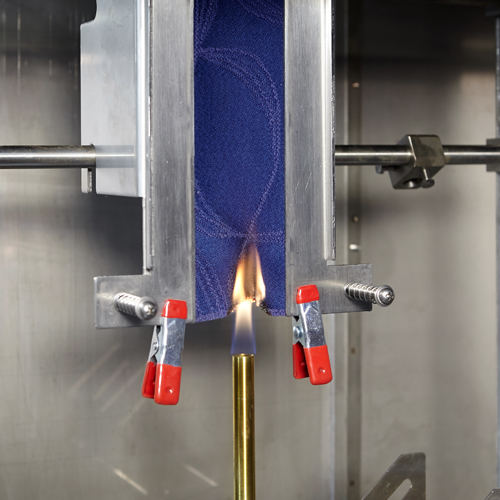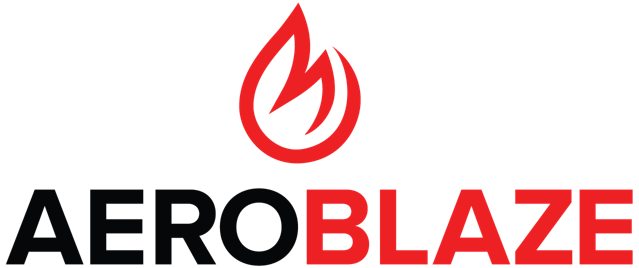Vertical Burn
Vertical Bunsen Burner Test (for aviation)
The Vertical Bunsen Burner test is used by the aerospace/aviation industry to determine the resistance of cabin and cargo compartment materials to a flame applied for either 12- or 60-seconds. It is most commonly used to show compliance with 14 CFR 25.853(a).
Test Methods

Test Summary
A test sample is aligned vertically and exposed to a small Bunsen burner flame at its lower edge. The flame is applied for 12 or 60 seconds and then pulled away from the sample. If the sample continues to flame, this flame time is recorded along with any flaming drips that may occur. After the test is over, the burn length is measured. The pass/fail criteria are based on the flame time, drip flame time, and burn length averaged across three test samples.
Test Sample Requirements
Test samples must meet the following requirements:
Regulatory Requirements
This test is typically used to show compliance with the following U.S. Federal Regulations:
Note 1: In the aviation industry, 14 CFR may also be referred to as "FAR" (Federal Aviation Regulations). You may see the requirements listed as FAR 23.853, FAR 25.853, FAR 25.855, etc.
Note 2: The European Union Aviation Safety Agency (EASA) uses similar Certification Specifications (CS) which correspond to those in the CFR. For example, the EASA regulations are listed as CS 23.853, CS 25.853, etc. These regulations may also be referred to as "JAR" (Joint Aviation Requirements) and listed as JAR 23.853, JAR 25.853, etc.
Products Requiring This Test
Items in commuter or transport category aircraft and in transport category rotorcraft require the Vertical Bunsen Burner Test when they are located in a compartment occupied by the crew or passengers. While there are some exceptions, these items typically include:
Vertical Burn, 12-second
Vertical Burn, 60-second
History of the Vertical Bunsen Burner Test
In 1965, following the deadly United Airlines Flight 727 crash in Salt Lake City, the Federal Aviation Administration (FAA) proposed more stringent requirements for cabin materials which were later adopted in 1967. Prior to 1967, materials were only required to undergo a Horizontal Bunsen Burner Test. The new Vertical Burn requirements were based on the 1951 Federal Specification CCC-T-191b, Method 5902 "Flame Resistance of Cloth, Vertical" with some modifications. This modified test method was incorporated into the Code of Federal Regulations (CFR), Title 14, Part 25 in 1967 through Amendment 25-15.
The Vertical Burn test underwent a few changes since its creation in 1967. Individual manufacturers and organizations also established their own internal versions of the Vertical Burn Test, such as Airbus (ABD0031/AITM 2.0002), Boeing (BSS 7230), McDonnell Douglas (DMS 1510 and 1511), and ASTM International (ASTM F501, withdrawn in 1998).
In order to facilitate improvements to the test standard without constantly changing the CFR, the FAA published Report DOT/FAA/CT-99/15 "Aircraft Materials Fire Test Handbook" in 1990. The tests in this handbook are considered an acceptable equivalent to those in the CFR. The handbook was updated in 2000 to DOT/FAA/AR-00/12, with the 60-second and 12-second Vertical Bunsen Burner Tests located in Chapter 1 of the handbook.
Sources: Federal Register Vol. 32, No. 182
Additional Resources
| Resource | Description |
|---|---|
| 14 CFR 23.853 |
Passenger and Crew Compartment Interiors (Normal, Utility, Acrobatic, and Commuter Category Airplanes) U.S. Regulations for FAR 23.853 at Amendment 23-62. (Historical) |
| 14 CFR 23.855 |
Cargo and Baggage Compartment Fire Protection (Normal, Utility, Acrobatic, and Commuter Category Airplanes) U.S. Regulations for FAR 23.855 at Amendment 23-49. (Historical) |
| 14 CFR 23, Appendix F |
Appendix F to Part 23 (Commuter Category Airplanes) U.S. Regulations, Criteria and Test Procedures, Part 23. (Historical) |
| 14 CFR 25.853 |
Compartment Interiors (Transport Category Airplanes) U.S. Regulations for FAR 25.853 at Amendment 25-116. |
| 14 CFR 25.855 |
Cargo or Baggage Compartments (Transport Category Airplanes) U.S. Regulations for FAR 25.855 at Amendment 25-142. |
| 14 CFR 25, Appendix F |
Appendix F to Part 25 (Transport Category Airplanes) U.S. Regulations, Criteria and Test Procedures, Part 25. |
| 14 CFR 29.853 |
Compartment Interiors (Transport Category Rotorcraft) U.S. Regulations for FAR 29.853 at Amendment 29-30. |
| 14 CFR 29.855 |
Cargo and Baggage Compartments (Transport Category Rotorcraft) U.S. Regulations for FAR 29.855 at Amendment 29-30. |
|
FAA Fire Test Handbook, Chapter 1 |
FAA Aircraft Materials Fire Test Handbook (DOT/FAA/AR-00/12); Chapter 1; Vertical Bunsen Burner Test for Cabin and Cargo Compartment Materials. This handbook provides an acceptable means of compliance with the relevant regulations. This is the preferred test method to find compliance with the listed regulations. |
|
FAA Policy Memo PS-ANM-25.853-01-R2 |
Flammability Testing of Interior Materials This policy memo provides guidance on acceptable methods of compliance with the flammability requirements of 14 CFR Part 25 for commonly constructed parts, construction details, and materials. |
Ask the Experts

Stuck? Our experts will help you determine the best solution for your needs.
Contact Us